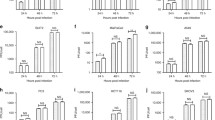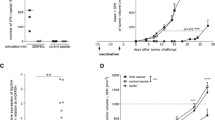Abstract
Purpose. To evaluate the possibility of cancer gene therapy by the gene delivery of chemokine, the effects of human macrophage inflammatory protein lα (hu-MIP-lα), murine-macrophage inflammatory protein lα (mu-MIP-lα), and human-interleukin 8 (hu-IL-8) on tumor progression and immunization were studied.
Methods. Cachexia-inducing and highly tumorigenic adenocarcinoma cells (cell line colon 26, clone 20) were transfected with either a control plasmid, hu-MIP-lα, mu-MIP-lα, or hu-IL-8 expression vector. The production of hu-MIP-1α reached >1.5 ng/ml in vitro when transfectant cells were cultured at a cell density of 2 × 105 cells in 7 ml for 3 days. Immunocompetent BALB/c mice were inoculated into the footpad with the tumor cells, and then primary tumor growth, morphological analyses, and tumor immunogenicity were studied.
Results. The secretion of hu-MIP-lα, mu-MIP-lα, and hu-IL-8 did not affect the growth rate in vitro. Reduced tumorigenicities in vivo were observed in transfected cells with hu-MIP-lα and mu-MIP-lα. Morphologic observation of the site of inoculation of cells transfected with hu-MIP-lα showed infiltration of macrophages and neutrophils on the 5th day after the inoculation. Mice that had rejected cells transfected with hu-MIP-lα gene were immune to a subsequent challenge with the parental cells.
Conclusions. The rejection of the cells depends on cytolysis and generates potent and long lasting antitumor immunity. These data suggest that tumor cells transfected with the MIP-lα gene might be useful as an effective therapy for the treatment of certain tumors.
Similar content being viewed by others
REFERENCES
D. D. Taub and J. J. Oppenheim. Cytokine. 5:175–9(1993).
J. J. Oppenheim, C. O. Zachariae, N. Mukaida, and K. Matsushima. Annu Rev Immunol. 9:617–48(1991).
K. Matsushima, C. G. Larsen, G. C. DuBois, and J. J. Oppenheim. J Exp Med. 169:1485–90(1989).
J. M. Wang, B. Sherry, M. J. Fivash, D. J. Kelvin, and J. J. Oppenheim. J Immunol. 150:3022–9(1993).
E. Nakashima, N. Mukaida, Y. Kubota, K. Kuno, K. Yasumoto, F. Ichimura, I. Nakanishi, M. Miyasaka, and K. Matsushima. Pharm Res. 12:1598–1604(1995).
K. Hirose, M. Hakozaki, Y. Nyunoya, Y. Kobayashi, K. Matsushita, and T. Takenouchi. Brit J Cancer 72:708–714(1995).
R. K. Singh and I. J. Fidler. Lymphokine Cytokine Res. 12:285–91(1993).
G. Strassmann, Y. Masui, R. Chizzonite, and M. Fong. J Immunol 150:2341–5(1993).
C. Chen and H. Okayama. Mol Cell Biol 7:2745–52(1987).
Y. Ko, N. Mukaida, A. Panyutich, N. N. Voitenok, K. Matsushima, T. Kawai, and T. Kasahara. J Immunol Methods 149:227–35(1992).
M. P. Colombo and G. Forni. Immunol Today 15:48–51(1994).
H. Hock, M. Dorsch, U. Kunzendorf, Z. Qin, T. Diamantstein, and T. Blankenstein. Proc Natl Acad Sci U S A 90:2774–8 (1993).
A. D. Luster and P. Leder. J Exp Med 178:1057–65(1993).
S. K. Ahuja, J. L. Gao, and P. M. Murphy. Immunol Today 15:281–7(1994).
J. H. McKie and K. T. Douglas. Drug Des Discov 11:47–59(1994).
Author information
Authors and Affiliations
Rights and permissions
About this article
Cite this article
Nakashima, E., Oya, A., Kubota, Y. et al. A Candidate for Cancer Gene Therapy: MIP-lα Gene Transfer to an Adenocarcinoma Cell Line Reduced T\imorigenicity and Induced Protective Immunity in Immunocompetent Mice. Pharm Res 13, 1896–1901 (1996). https://doi.org/10.1023/A:1016057830271
Issue Date:
DOI: https://doi.org/10.1023/A:1016057830271




